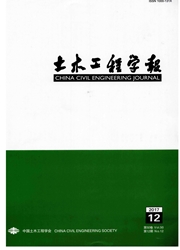

 中文摘要:
中文摘要:
揭示悬索桥主缆系统的扭转刚度退化及静力扭转发散的机制。基于广义模型的理论分析表明,桥面的竖向运动对系统整体的扭转刚度至关重要。任何一条主缆的向上竖向运动都可能导致系统扭转刚度的急剧降低。由于竖向运动引起的刚度急剧降低是紊流场中大跨度悬索桥发生静力扭转发散的主要原因。紊流场中因系统刚度退化而引起扭转发散的机制与传统的观点不同。通过广义模型较好地解释了如果任意一条主缆丧失了刚度都将导致主缆系统扭转刚度的消失。此外,由这个机制町以得到与紊流场中悬索桥静风扭转发散有关的几个临界风速的定义,其中能导致任意一根主缆达到无应力状态时的风速玑。对扭转发散至关重要。酉堠门大桥非线性动力有限元数值分析的结果和全桥气弹模型风洞试验的观察结果证实文章提出的基本观点。
 英文摘要:
英文摘要:
The mechanism of torsional stiffness degeneration of cable system and aerostatie torsional divergence of suspension bridges is investigated. Theoretical analysis based on a generalized model indicates that vertical motion of the bridge deck is crucial to the torsional stiffness of the whole system; upward directed vertical motion of either cable beyond a threshold could result in a sharp drop in torsional stiffness of the system. This sharp drop in stiffness induced by vertical motion is the main reason for aerostatic torsional divergence of a long-span suspension bridge immersed in a turbulent wind field. The mechanism of the torsional divergence in turbulent flow differs from the traditional concep that the stiffness degeneration of the system itself is an important reason. By the generalized model, the phenomenon that the loosening of any one cable could result in the vanishing of the torsional stiffness contributed by the cable system is well explained. Moreover, this mechanism leads to the definition of several wind speed thresholds related to torsional divergence in turbulent flow, among which the one that could result in a motion with a magnitude so large as to loosen either cable to a strainless state is of utmost importance. Numerical results of the Xihoumen Suspension Bridge, by the nonlinear Finite Element (FE) analysis and the observations from aero-elastic full bridge model tests in wind tunnel prove the basic standpoint proposed in this literature.
 同期刊论文项目
同期刊论文项目
 同项目期刊论文
同项目期刊论文
 期刊信息
期刊信息
